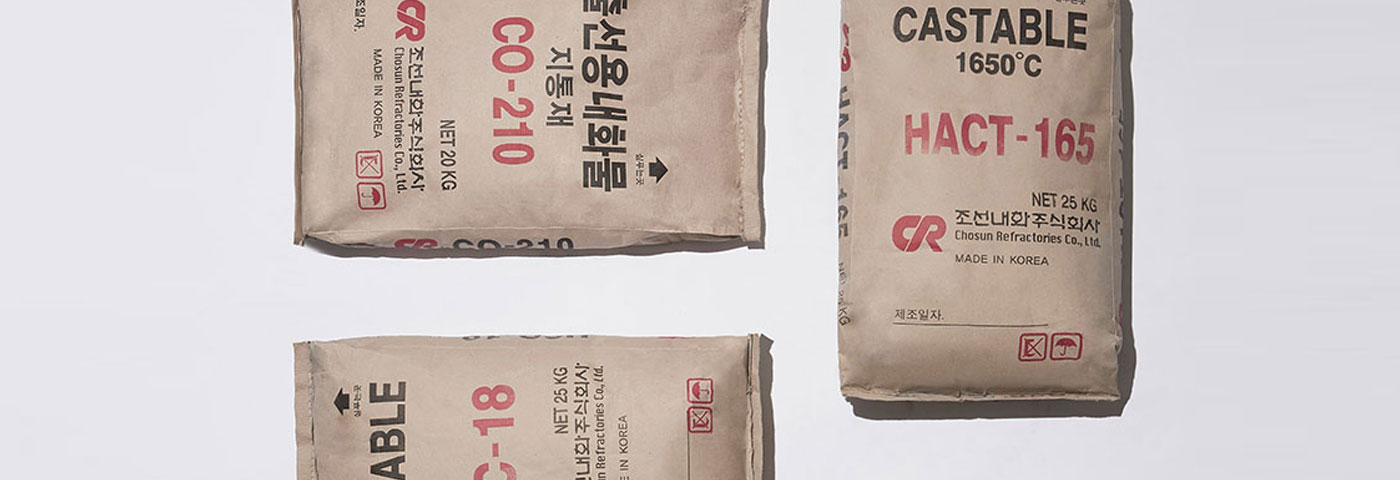Monolithic Refractories
Monolithic refractories involve slip casting castables, stamping refractories, patching refractories, gunning/spray refractories, pre-cast blocks and mortar, and are kneaded with binders (water and special binders) before construction. Compared to shaped ones, monolithic refractories are easier to use, and thus widely applied to steel making, boilers and incinerators. The dispersion and coagulation technology ensures hot corrosion resistance, spalling resistance and volume stability.
| Product | Product name | Description |
|---|---|---|
| Castables | Castable Refractories | Water or liquid binders are added to refractory aggregate, fine matrix and bond binders and kneaded before construction to form refractory structures. |
| Dense and High-Strength Castables | Dispersion, peptization and flocculation theories are applied when special binders are used. High-performance thermal properties appear with infinitesimal amounts of alumina cement. Super micro grains facilitate construction, requiring low levels of moisture addition. High strength manifested across all temperature ranges ensures excellent abrasion resistance, corrosion resistance and spalling resistance. |
|
| Special SiC Castables | Contains SiC and features superior thermal shock resistance, alkali resistance, abrasion resistance and coating resistance. Stable even in harsh conditions including thermal power plants for C-FBC, cement plant cyclones and incinerators. |
|
| Acid-Proof Castables | Excellent resistance against acids. Used in anti-pollution facilities and chemical plants to prevent damages due to acidic gases or alkali ingredients. Optimally designed castables for diverse conditions are available. Slip casting castables and spray refractories are customized for each construction method. |
|
| Light-Weight Castables | Low density and high insulating capacity prevent heat loss, saving fuel costs. Special light-weight refractory aggregate used for ultra-high temperature products. |
|
| Gunning refractories | Special High-Density Gunning Refractories | Spray refractories shorten the lead time and are effectively applicable to challenging parts in comparison to castables. Special hardening binders are used for betterment of workmanship and adhesion, which ensures superior quality and volume stability. |
| Gunning Refractories | Applicable to places where insulating castables are hardly applicable, e.g. petrochemical plants. Mostly made from high-purity light-weight insulating aggregate and alumina cement. Special hardeners are used for better adhesion. |
|
| Plastic refractories | Plastic Refractories | Water or chemical binders are added to refractory aggregate combined with clay for better workmanship. Plastic refractories are convenient and applicable immediately using air rammers without mixing and kneading. |
| Ramming mix & induction furnace | Ramming Mix and Induction Furnace Stamping Refractories | Ramming Mix Withstanding repeated thermal loads with excellent corrosion resistance and spalling resistance. Applicable to urgent repairing or frame-less parts using an air rammer. Induction Furnace Stamping Refractories Powders are used with a vibrator or rod, and burned before use. Products designed in conformance with steel casting or cast iron induction furnaces are available. |
| Blast furnace runner refractories | Blast Furnace Runner Refractories | Used until hot metals run from blast furnaces flow into ladles or torpedo cars. As blast furnaces are scaled up, work conditions become harsher with increasing productions and hot metal temperatures, which requires high-quality hot iron runner refractories. |
| Blast Furnace Top-Hole Refractories | Used for iron notch (tap hole) and features excellent filling and opening properties. As blast furnaces are scaled up, work conditions become harsher including the increasing production temperature, time and frequency, which warrants development and use of special non-oxide materials and new tar/resin. High-temperature resistance, wear resistance, slag resistance and low-temperature burning contribute to volume stability. |
|
| Ladle & turndish refractories | Ladle and Turndish Refractories | Used to protect units and custom-designed with refractory materials fit for unit properties and work conditions. Excellent volume stability against molten steel & slag. Easy-to-use products developed with quality technology are available. Product lifespan is extended with repairing technology, which contributes to consumption unit/price savings. |
| Flame-gunning repair refractories | Flame-Gunning Repair Refractories | Refractory grains are melted with flames and sprayed onto base (parent) metals to repair damaged parts of refractories. Structures constructed with flame gunning maintain properties equal to base metals, with good adhesion, leading to high corrosion resistance and high strength. With good flowability kept in pipes and nozzles, these products feature optimum melting properties and resistance in flames. |
| Mortar | Mortar | Mortar refractories are fit for use in accordance with properties and purposes of refractory bricks in diverse facilities. Sub-divided into air and heat setting refractory mortars based on hardening properties. Characterized by superior volume stability, strong adhesion and good workability. |
| Casting blocks | Special Casting Blocks | Used for blocks of complex, not simple, shapes. Self-flowing castables are used to produce complex shapes. Products are customized for customer requirements and unit properties. |
| Casting Blocks | Both dense castables and castable refractories are used to produce blocks. Blocks show superior abrasion, erosion and spalling resistances to castables. |



